- powerhouse equipment and supplies
- 0 likes
- 3963 views
- 1 comments
Burners Buying Important Tips
Want to use burners to convert fossil fuel energy to thermal energy in different tanks, heaters, and even gas combi boilers but you are not sure of the type, capacity, brand, price, and specifications that suit your purpose? Read on to find the answers to all your questions on burner price, technical specifications, and the best gas, gasoline, and dual-fuel burners on the market.
A burner is a component that mixes a specific ratio of fuel and air (based on capacity) and then ignites the mixture to produce heat from the fuel. The energy produced by the burner is transferred by radiation and convection to the fluid (mostly water) used in the heating system via the boiler.
Burners produce the source heat in boilers, heaters, and even tankless water heaters and act as the core of each heating system. They spray the fuel (gas, heavy oil, diesel fuel) and mix it with the air, pass it through a spreading component, and then ignite it via a spark in the combustion chamber to produce the heat required by a boiler or furnace. Burners and boilers include a number of controllers such as relays, photocells, ion, and thermostats, which are responsible for controlling the amount and timing of each process.
Considering the imperfect combustion efficiency of burners and some other sources of heat loss, the burner capacity is usually selected 20% above that of the respective boiler.
Click to view brands, models, and different types, find out the price, and Buy a burner.
Four points to consider about fuel combustion
- The heating value of a liter of diesel fuel is about 8,500 kcal
- The heating value of each kilogram of diesel fuel is about 10,500 kcal
- The heating value of each cubic meter of natural gas is approximately 9,200 kcal
- For every 300 meters of increased altitude from sea level, the reduction in air density decreases the combustion efficiency of most burners by about 4%
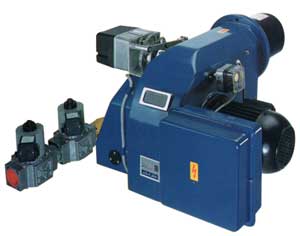
To select the burner, determine the fuel type and the respective heating value, the diameter of the flame trap tube for placement in the boiler, and the possibility of installing the burner in front of the boiler. You can consult with the technicians at Damatajhiz Co. to select your optimal burner.
Burners based on fuel-type
- Gas burner
- Light oil burner
- Dual burner
- Heavy oil burner
- Multi burner
General Burners operations
- In fan burners, the onset of operation is based on the boiler thermostat and relay schedule. First, the air intake fan activates for 30-60 seconds with the command of the relay, and then the spark plug activates. After that, the electric fuel valve (gas, diesel fuel, mazut) opens and the fuel enters the combustion chamber of the boiler or heater. A spark then produces flame in front of the flame spreader.
- After the flame is produced, there will be no need for sparks or electric arcs, and commanded by the photocell or ion, the spark plug deactivates and the burner continues burning until the thermostat commands it to extinguish.
- The electromotor of the air intake fan works with single- or three-phase electricity based on the burner capacity and at a rotational velocity of 2900 RPM.
- The body of a diesel or gas burner is normally made of cast aluminum, on which the other components are attached.
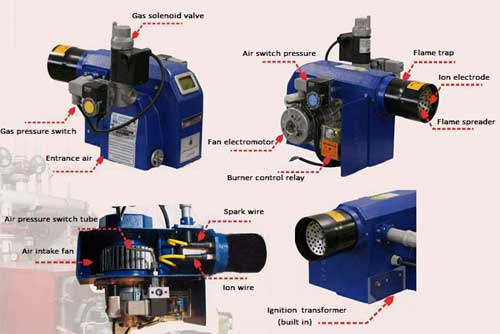
Gas burner
- The employed gas burners are designed to burn natural gas. The flow rate of gas is regulated by an electric valve and the combustion air is supplied by a blower installed on the motor axis.
- Based on the capacity, the airflow rate is regulated manually or automatically by a damper on the burner.
- The gas passes through a filter, mixes with the air, and gets ready for combustion. If the combustion air pressure is insufficient or the gas pressure exceeds or drops below the considered gas pressure, the pressure sensors cause the burner to turn off via air and gas pressure switches controlled through a relay.
- Gas burners come in the blower- or fan-equipped and fan-less (silent) types. Burners in apartment tankless water heaters are of the gas-powered type without blowers (silent).
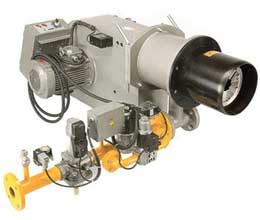
Diesel burner
- Diesel burners use centrifugal fans for air intake. The fan is installed on the electromotor shaft with a rotational velocity of 2900 RPM.
- When the motor starts, the air intake fan activates and the air starts flowing through the fins. The airflow is controlled by a damper at the intake gate, which is operated manually in small burners and by a servomotor in large burners. The airflow through the damper is regulated based on fuel quantity.
- The diesel pump in high-pressure burners is normally of the rotary or gear type.
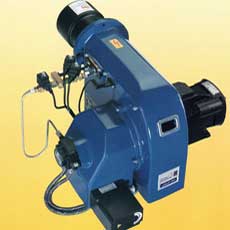
The operating mechanism of the liquid fuel burner
The liquid fuel is vaporized (atomized) completely via a diesel or mazut pump to achieve proper combustion. The powdered liquid fuel is mixed with air via single or multiple nozzles (based on capacity). The air-fuel mix combusts with a spark generated by the spark plug. The combustion products must exit the combustion chamber after exchanging the heat.
Common features of the liquid fuel burner
- Require to atomize the liquid fuel;
- Require the air and combustion air to mix.
Liquid fuels need to be atomized before combustion because mostly they have a low octane rating and are not easy to ignite when in the liquid phase.
For instance, putting a lit match in a barrel of oil kills the flame quickly. Such fuels need to be vaporized (atomized) before ignition. Atomization increases the contact between the fuel and oxygen and enhances ignition.
For example, using a nozzle it is possible to convert oil fuel with a flow rate of 1 GPH under the operating pressure 7 bar into more than 50 billion oil droplets. The droplets vary between 0.0002–0.01 inches in diameter.
Four main groups of liquid-fuel burners
- Pressure jet
- Rotary cup
- Air/steam atomized
- Low-pressure air atomizing
Mazut burner
- These burners use a nozzle to vaporize the fuel. The droplets must have a specific pattern and leave the nozzle at a certain angle with uniform distribution. The most common pattern for the flow is the conical shape.
- The vaporization of fuel requires energy. The said energy enters the system via a diesel or mazut pump as pressure, which is then converted into velocity.
- When using a mazut burner, a preheater for fuel is necessary to prevent reduced flexibility of mazut in cold conditions.

Types mechanism of liquid fuel nozzles used in burners
A small component known as nozzle sprays fuel in pressure jet burners that use liquid fuel.
Nozzles vary regarding their flow rate and spray pattern and angles. The diesel pump pumps the fuel into the nozzle with pressure. When leaving the orifice, fuel escapes the center of the nozzle by the centrifugal force as a thin, high-velocity layer. There are three main types of nozzles by their spray pattern. The spray angle and pattern must be selected according to the combustion chamber and burner design. The standard fuel spray angles in nozzles are 30, 350, 60, 70, 80, and 90 degrees.
Read the “Selecting a nozzle for diesel burner” article for more information on the calculations and selection of liquid fuel nozzles for burners.
Air and fuel regulation in the burner
Perfect combustion is achieved by accurately regulating the air-fuel ratio. The more accurate this ratio, the better the combustion efficiency and the less fuel consumption. In smaller burners, a manually operated damper regulates this ratio, but in larger burners, an automated damper regulates air feed. As the temperature and humidity of the boiler vary during the year, large burners need re-configuration for their air damper in each season. Nowadays, modern burners employ a smart control system (PLC) to automatically regulate the air-fuel ratio during the day and all seasons.
Bi-fuel and multi-fuel burner
- A burner that can burn more than a single fuel type is called bi-fuel or multi-fuel.
- Bi-fuel burners normally use gas and diesel fuels. Burners that also burn mazut are called multi-fuel.
- Multi-fuel burners need to use a preheater same as mazut burners and can use gas, diesel, and mazut fuels.
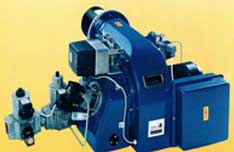
Final speech
The specialized collection (Damatajhiz) (the first and most reliable authority in the country in the field of building facilities equipment and all air conditioning devices), offers you all kinds of sand filters and hundreds of other products, guaranteeing the originality of the product, valid warranty, and reasonable price. In addition, if you have any questions about choosing and comparing the brands of this product, you can get free advice from the heating equipment experts.
In Iran, the first and most famous specialized group in the field of building installation equipment, air conditioners, and all equipment for swimming pools, saunas, and jacuzzis since 2004, DamaTajhiz is a specialized group. Refer to the time of this group. For more information, you can get advice from the experts of DamaTajhiz Engineering and Production Company by calling 021-88822550.

We are waiting for your call and look forward to meeting you at the DAMATAJHIZ group
By sharing the above article on social networks, let your friends know about its important content.







Comments (1)